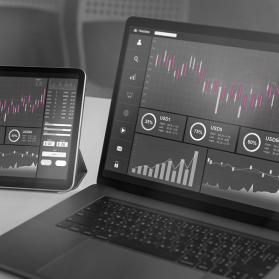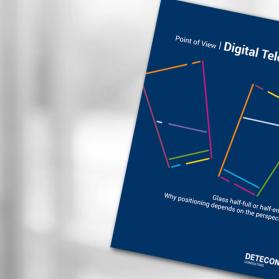It still sounds promising: data is the oil of the 21st century. But it's not quite that simple. There is a market for oil and defined prices. But what does data cost? And how should data be traded? The following is an excerpt of an interview with Volker Rieger and Steffen Kuhn from the LÜNENDONK magazine "Artificial Intelligence" on these questions.
Lünendonk: In 2025, the volume of digital data generated annually worldwide is expected to be 175 zettabytes. A number with 21 zeros. What do we do with this data?
Dr. Volker Rieger: Many of our customers are also looking for an answer to this question. They first collect internal data to evaluate it on their systems. To do this, they rely on artificial intelligence or machine learning, improve business processes, reduce costs, and analyze their customers. In simple terms, this is business intelligence (BI) based on new technologies. However, data becomes even more interesting when companies gold-plate it by exchanging and blending their data and analysis results with those of other organizations, even to the point of trading them on electronic marketplaces, for example. For Internet companies whose business concept is based entirely on this, this is everyday life. For Facebook or Google, for example - even if not all concrete cases are always to be approved of.
Are these companies suitable as role models for industrial companies?
Dr. Volker Rieger: It is indeed more complicated there, because data in the corporate environment often contains business secrets. Technically, it is also more difficult, as the data often resides in proprietary systems and data silos. However, data-centric, digital business models will become a driver of growth in the medium term. The pace of development has been accelerating as technologies such as Big Data and Artificial Intelligence have matured. It is therefore important that all companies - regardless of industry and size - begin to formulate their own service- and data-centric strategy and gain experience with initial implementation steps. To do this, they should establish an overarching view of the relevant data, learn to understand how data affects their own business model, or even develop new business models with data. To this end, the Chief Digital Officer could also see himself as the Chief Data Officer.
But industrial companies tend to collect machine data? For whom could such data be interesting?
Steffen Kuhn: There is no blanket answer to that. We have to look at the data individually. In Germany, for example, we have a number of machine manufacturers whose machines are used worldwide. Their customers collect IoT data for predictive maintenance purposes or to improve production processes. Together with information on raw materials, the temperature in production or deliberately changed production conditions, these customers recognize whether and when components fail more frequently under certain conditions. The manufacturer itself can use the data to improve its machines and reduce failures from the outset. But he could also make the data available to other customers, companies or partners. A small data market is already emerging from such a scenario.
Who owns the data there?
Steffen Kuhn: There is no one answer to the question of how to divide up ownership of data in partnerships in the so-called shared data economy. But one thing is certain: We need data sharing. So we need to find models to commercialize that. It is highly recommended to develop a mechanism that makes certain, sometimes very specific data such as wear data of machines or objects and their value tradable - be it via pricing models based on values or on costs, i.e. value- or cost-based. Pay-as-you-use models are conceivable here, for example, which only allow data to be used once. Partner models in a data-centric ecosystem should therefore be structured in such a way that those who input data actually get data values back out again. Similar to a points system according to the motto "Sharing is caring - those who put a lot in can also take a lot out." The value of the data could then be determined on the basis of various use cases developed for this purpose, which would be a start. It would be conceivable for a neutral partner to control such a system as the "referee" of a platform, so to speak.
Isn't the value hard to define?
Dr. Volker Rieger: That is indeed still the biggest construction site. Pricing is not trivial. It has to evolve. A price has long been developed for customer profile data. If you want to know, for example, how likely customers are to buy, you pay 25 to 50 U.S. dollars for such profile data. Once a value is defined, a data economy also emerges. If I'm a plant operator, I can use predictive maintenance to calculate how high the value is in my own company. It becomes more difficult if I am a plant manufacturer and want to sell this knowledge to the operator. In the automotive sector, for example, there are now start-ups that evaluate vehicle sensors as a third party and use them to calculate the wear and tear on vehicle parts. This is interesting for maintenance intervals on the one hand, but also for resale value on the other. Here, there are potentially several interested parties for such data, and in connection with resale, the value could quickly reach several thousand euros.
The complete interview as well as the entire LÜNENDONK magazine "Artificial Intelligence" are available for download in German-language here








